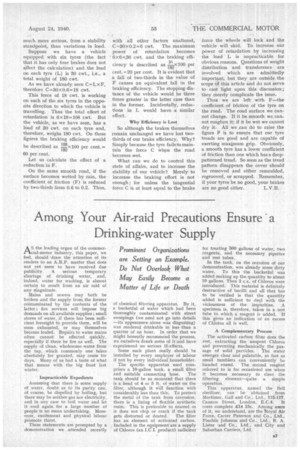Among Your Air-raid Precautions Ensure a Drinking-water Supply
Page 25

If you've noticed an error in this article please click here to report it so we can fix it.
Prominent Organizations are Setting an Example. Do Not Overlook What May Easily Become a Matter of Life or Death A S the leading organ of the commerrAcial-motor industry, this paper, we feel, should draw the attention of its readers to an A.R.P. matter that does not yet seem to have received due publicity. A serious temporary shortage of drinking water, and, indeed, water for washing, is almost certain to result from an air raid of any niagnitude.
Mains and sewers may both be broken and the supply from the former contaminated by the contents of the latter ; fire services will impose big demands on all available supplies ; small stores of water, if there has been suffi. cient foresight to provide them, will be soon exhausted, or may themselves become fouled. Repairs to water mains often cannot be effected quickly, especially if there be fire as well. The supply of clean, wholesomewater from the tap, which commonly one takes absolutely for granted, may cease for days. Many of us had a taste of what that means with the big frost last winter.
Impracticable Expedients
Assuming that there is some supply of water, doubt as to its purity can, of .course, be dispelled by boiling, but there may be neither gas nor electricity, and in any case to boil water and let it cool again for a large number of people is no mean undertaking. Moreover, excitement and physical labour promote thirst.
. These statements are prompted by a demonstration we attended recently
of chemical filtering apparatus. By it, a bucketful of water which had been thoroughly contaminated with street sweepings (we need not go into details —its' appearance alone was disgusting) was rendered drinkable in less-than a quarter of an hour. In order that we might honestly recommend the process, we ourselves drank some of it and have experienced no serious ill-effects, Some such plant really should be installed by every employer of labour if not by every individual householder.
The specific apparatus used comprises a 10-gallon tank, a small filter and suitable connecting hose. The tank should be so mounted that there is a head of 4 or .5 ft, of water, on the filter, although it function with considerably less than this. To protect the metal of the tank from corrosion, there is a lining of flexible synthetic resin,This is preferable to enamel as it does not chip or crack if the tank gets distorted or dented. The filter has an element of activated carbon. Included in the equipment are a supply of Chloros (an I.0 I. product) sufficient
for treating 54)0 gallons of water, two reagents, and the necessary pipettes and test tubes.
. In the tank, on the occasion of our demonstration, was already some dirty water. To this the bucketful • was added making up the quantity to about 10 gallons. Then 2 c.c. of Chloros were introduced. This material is definitely destructive of bacilli and all that has to be verified is that the quantity added is sufficient to deal withthe viciousness of the impurities. A specimen is, therefore, taken in a test tube, to which a reagent is added. If this gives an indication of an excess of Chloros all is well.
A Complementary Process
The activated carbon filter does the rest, extracting the unspent Chloros and preventing mechanically the pas sage of solid particles. The water emerges clear and palatable, as fast as small tumblers can conveniently be handed round. The second reagent referred to is for occasional use when it becomes necessary to clear the filtering element—quite a simple operation.
This apparatus, named the Bell sterilizer, can be obtained from Mortimer, Gall and Co., Ltd., 115-117, Cannon Street, London, E.C.4. It costs complete 214 15s. Among users of it, we understand, are the royal Air Force, Carter Paterson and Co., Ltd., Pinchin Johnson and Co., Ltd., R. A. Lister and Co., Ltd., and City and Suburban Carriers, Ltd.




















































